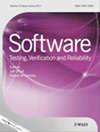Effective automated repair of internationalization presentation failures in web applications using style similarity clustering and search‐based techniques
IF 1.2
4区 计算机科学
Q3 COMPUTER SCIENCE, SOFTWARE ENGINEERING
引用次数: 9
Abstract
Companies often employ (i18n) frameworks to provide translated text and localized media content on their websites in order to effectively communicate with a global audience. However, the varying lengths of text from different languages can cause undesired distortions in the layout of a web page. Such distortions, called Internationalization Presentation Failures (IPFs), can negatively affect the aesthetics or usability of the website. Most of the existing automated techniques developed for assisting repair of IPFs either produce fixes that are likely to significantly reduce the legibility and attractiveness of the pages or are limited to only detecting IPFs, with the actual repair itself remaining a labour intensive manual task. To address this problem, we propose a search‐based technique for automatically repairing IPFs in web applications, while ensuring a legible and attractive page. The empirical evaluation of our approach reported that our approach was able to successfully resolve 94% of the detected IPFs for 46 real‐world web pages. In a user study, participants rated the visual quality of our fixes significantly higher than the unfixed versions and also considered the repairs generated by our approach to be notably more legible and visually appealing than the repairs generated by existing techniques.使用风格相似聚类和基于搜索的技术有效地自动修复web应用程序中的国际化表示失败
公司经常使用(i18n)框架在其网站上提供翻译文本和本地化媒体内容,以便有效地与全球受众进行交流。然而,来自不同语言的不同长度的文本可能会导致网页布局中的不希望的扭曲。这种扭曲被称为国际化呈现失败(ipf),会对网站的美观性或可用性产生负面影响。为协助修复ipf而开发的大多数现有自动化技术要么产生可能大大降低页面的易读性和吸引力的修复,要么仅限于检测ipf,实际修复本身仍然是一项劳动密集型的手工任务。为了解决这个问题,我们提出了一种基于搜索的技术来自动修复web应用程序中的ipf,同时确保页面的可读性和吸引力。我们的方法的经验评估报告说,我们的方法能够成功地解析94%的检测到的46个真实世界的网页ipf。在一项用户研究中,参与者认为我们修复的视觉质量明显高于未修复的版本,并且认为我们的方法生成的修复比现有技术生成的修复更清晰,更有视觉吸引力。
本文章由计算机程序翻译,如有差异,请以英文原文为准。
求助全文
约1分钟内获得全文
求助全文
来源期刊

Software Testing Verification & Reliability
工程技术-计算机:软件工程
CiteScore
3.70
自引率
0.00%
发文量
34
审稿时长
>12 weeks
期刊介绍:
The journal is the premier outlet for research results on the subjects of testing, verification and reliability. Readers will find useful research on issues pertaining to building better software and evaluating it.
The journal is unique in its emphasis on theoretical foundations and applications to real-world software development. The balance of theory, empirical work, and practical applications provide readers with better techniques for testing, verifying and improving the reliability of software.
The journal targets researchers, practitioners, educators and students that have a vested interest in results generated by high-quality testing, verification and reliability modeling and evaluation of software. Topics of special interest include, but are not limited to:
-New criteria for software testing and verification
-Application of existing software testing and verification techniques to new types of software, including web applications, web services, embedded software, aspect-oriented software, and software architectures
-Model based testing
-Formal verification techniques such as model-checking
-Comparison of testing and verification techniques
-Measurement of and metrics for testing, verification and reliability
-Industrial experience with cutting edge techniques
-Descriptions and evaluations of commercial and open-source software testing tools
-Reliability modeling, measurement and application
-Testing and verification of software security
-Automated test data generation
-Process issues and methods
-Non-functional testing
 求助内容:
求助内容: 应助结果提醒方式:
应助结果提醒方式:


